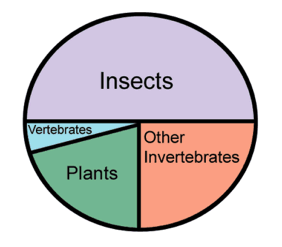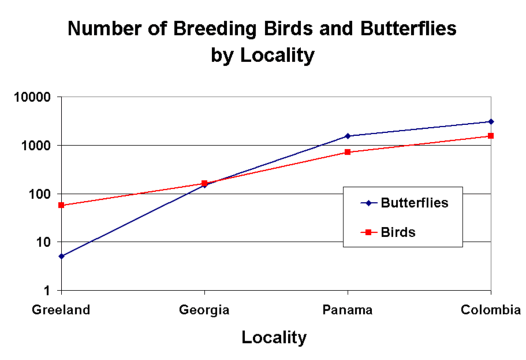Texas
Arkansas
Louisiana
New Mexico
Oklahoma
| Rank |
Plants |
Mammals |
Birds |
Reptiles |
Amphibians |
Fishes |
Butterflies |
| 1 |
California |
California |
Texas |
Texas |
North Carolina |
Alabama |
Texas |
| 2 |
Texas |
Texas |
New Mexico |
Arizona |
Georgia |
Tennessee |
Arizona |
| 3 |
Arizona |
New Mexico |
Arizona |
New Mexico |
Virginia |
Georgia |
New Mexico |
| 4 |
New Mexico |
Oregon |
California |
Florida |
Tennessee |
Kentucky |
Colorado |
| 5 |
Oregon |
Arizona |
Florida |
California |
Texas |
Mississippi |
California |
McDaniel, N. 2002. Texas
is second-most biologically diverse state in U.S. Nature
Conservancy, San
Antonio, TX. Press Release.
Stein, B.A. 2002. States
of the Union: Ranking America’s Biodiversity. NatureServe,
Arlington,
Virginia. 25 pp.
R.E.
Stanford
& P.A. Opler. 1993. Atlas of western USA butterflies,
including
adjacent parts of Canada and Mexico. Published by authors. Denver,
Colorado. 275
pp.
Centres
of Plant Diversity and Endemism - Smithsonian
-----------------------------------------------------------------------------
Species
Richness and Trends of Western Butterflies and Moths - Paul
A. Opler
Number of species of selected
Lepidoptera by
state:
| State |
Hawk-
moths |
Silk-
moths |
Butter-
flies |
Tiger
moths |
Total |
Top 5
|
| Texas |
69 |
34 |
127 |
290 |
520 |
1
|
| Arizona |
49 |
31 |
111 |
246 |
437 |
2 |
| New Mexico |
31 |
24 |
83 |
272 |
410 |
3 |
| Colorado |
32 |
18 |
71 |
230 |
351 |
4 |
| California |
30 |
17 |
52 |
225 |
324 |
5 |
| Idaho |
16 |
7 |
24 |
154 |
201 |
|
| Kansas |
23 |
9 |
34 |
133 |
199 |
|
| Montana |
10 |
6 |
27 |
184 |
227 |
|
| Nebraska |
36 |
10 |
38 |
170 |
254 |
|
| Nevada |
18 |
9 |
28 |
181 |
236 |
|
| North Dakota |
30 |
3 |
16 |
132 |
181 |
|
| Oklahoma |
39 |
13 |
30 |
146 |
228 |
|
| Oregon |
23 |
9 |
28 |
154 |
214 |
|
| South Dakota |
12 |
7 |
32 |
149 |
200 |
|
| Utah |
24 |
14 |
46 |
197 |
281 |
|
| Washington |
17 |
8 |
27 |
140 |
192 |
|
| Wyoming |
18 |
7 |
49 |
197 |
271 |
|
| Totals
for western U.S. |
99 |
68 |
219 |
529 |
915 |
|
Museum Collections -
(Invertebrate)
Databases -
(Invertebrate & Botanical)
Botanical
Taxonomy -
(Invertebrate
& Plant)
Graph Comparing Bird and
Butterfly Diversity (Robbins
& Opler, 1996)
(First locality should be Greenland)
Global Diversity
Comparison (Robbins
& Opler, 1996)
Among the well-known taxonomic groups of terrestrial
animals,
butterflies have the greatest number of species. With 17,500 species,
they are
three to five times more numerous than mammals, amphibians, mosquitoes,
termites,
or dragonflies. There are approximately two species of butterflies for
every
species of non-marine bird, and a bit less than three species of
butterflies for
every one of reptiles.
Balcázar, M.A.L.
1997. Mexican
butterfly diversity. American Butterflies 5(4):28-35.
Bálint, Z. &
K. Johnson.
1995. Neotropical polyommatine diversity and affinities. I.
Relationships of the
higher taxa (Lepidoptera: Lycaenidae). Acta Zoologica Academiae
Scientiarum
Hungaricae 41(3):211-235.
Boettner, G. 2002. When
Biodiversity meets Biocontrol: The Thin Green Line Between Insect
Conservation
and Insect Control. Conservation Perspectives, the eJournal of the
New
England Chapter of the Society for Conservation Biology.
Colwell, R.K. & J.A. Coddington. 1994. Estimating terrestrial
biodiversity through extrapolation. Phil. Trans. R. Soc. Lond. B
345:101-118.
Colwell, R.K., C. Rahbek & N.J. Gotelli. 2004. The
mid-domain effect and species richness patterns: what have we learned
so far?
American Naturalist 163(3):E1-E23.
Danks, H.V. 1994. Regional Diversity of Insects in North America.
American
Entomologist 40(1):50-55.
DeVries,
P.J. 1994. Patterns of butterfly diversity and promising topics in
natural
history and ecology. Pp. 187-194 in: McDade, L.A., K.S. Bawa,
H.S.
Hespenheide, & G.S. Hartshorn, editors. La Selva, Ecology and
Natural
History of a Neotropical Rain Forest. University of Chicago Press,
Chicago.
DeVries, P.J., I.A. Chacon, & D. Murray. 1992. Towards
a better understanding of host use and biodiversity in riodinid
butterflies
(Lepidoptera). Journal of Research on Lepidoptera 31(1-2):103-126.
DeVries, P.J., D. Murray, & R. Lande. 1997. Species diversity in
vertical, horizontal, and temporal dimensions of a fruit-feeding
butterfly
community in an Ecuadorian rainforest. Biological Journal of the
Linnean Society
62:343-364.
Erwin, T.L. 1988. The tropical forest canopy--The heart of biotic
diversity.
Pp. 123-129 in: E.O. Wilson (ed.), Biodiversity. National
Academy Press,
Washington, D.C.
Erwin, T.L. 1997. Biodiversity at its utmost: Tropical forest
beetles. Pp.
27-40 in: M.L. Reaka-Kudla, D.E. Wilson, & E.O. Wilson
(eds.),
Biodiversity II. Joseph Henry Press, Washington, D.C.
Gilbert, L.E. 1991. Biodiversity of a Central American Heliconius
community:
Pattern, process, and problems. Pp. 403-427 in: Price, P.W.,
T.M.
Lewinsohn, G.W. Fernandes & W.W. Benson. editors. Plant-Animal
interactions:
Evolutionary ecology in tropical and temperate regions. Wiley, New
York. Spanish
translation.
Hafernik, J.E. 1992. Threats to invertebrate biodiversity:
implications for
conservation strategies. in: Fiedler, P.L. & S. K.
Jain,
editors. Conservation Biology: The theory and practice of nature
conservation,
preservation and management. Chapman and Hall, New York.
Hawksworth, D.L. & J.M. Ritchie. 1993. Biodiversity and
Biosystematic
Priorities: Microorganisms and Invertebrates. CABI, The University of
Arizona
Press, Tucson. 128 pp.
Heppner,
J.B. 1991. Faunal regions and the diversity of Lepidoptera. Tropical
Lepidoptera
2(Suppl. 1):1-85.
Holloway, J.D. & Stork, N.E. (1991): The dimensions of
biodiversity: the
use of invertebrates as indicators of human impact Pp. 37-62 in:
Hawksworth, D.L. editor. The Biodiversity of Microorganisms and
Invertebrates:
Its Role in Sustainable Agriculture. CAB International, Wallingford.
Johnson, K. 1978. Specificity, geographic distribution and foodplant
diversity in four Callophrys. Journal of the Lepidopterists'
Society
32(1): 3-19.
Kocher, S.D. & E.H. Williams. 2000. The
Diversity and Abundance of North American Butterflies Vary with Habitat
Disturbance and Geography. Journal of Biogeography 27,
785–794.
Llorente-Bousquets, J. & Luis-Martínez, A. 1993.
Conservation-oriented
analysis of Mexican butterflies: Papilionidae (Lepidoptera,
Papilionoidea). Pp.
147-177 in: Ramamoorthy, T.P., Bye, R., Lot, A. & Fa, J.E.,
editors.
Biological Diversity of Mexico: Origins and Distribution. Oxford
University
Press, New York.
Luis, A.M., J.B. Llorente, I.F. Vargas & A.D. Warren. 2003.
Biodiversity
and biogeography of Mexican butterflies (Lepidoptera: Papilionoidea and
Hesperioidea). Proceedings of the Entomological Society of Washington
105(1):209-224.
Mann, C.C. 1994. Fire ants parlay their queens into a threat to
biodiversity.
Science 263:1560-1561.
Morrison, L.W. & S.D. Porter. 2003. Positive
association between densities of the red imported fire ant, Solenopsis
invicta (Hymenoptera: Formicidae), and generalized ant and
arthropod
diversity. Environmental Entomology 32:548-554.
Naeem, S., Thompson, L.J., Lawler, S.P., Lawton, J.H. & Woodfin,
R.M.
1994. Declining biodiversity can alter the performance of ecosystems.
Nature
368:734–737.
Opler,
P.A. 1995. Conservation and management of butterfly diversity in North
America. in:
A.S. Pullin, editor. Ecology and Conservation of Butterflies. Chapman
and Hall,
London.
Peterson, A.T., O.A.
Flores, L.S.
León, J.E. Llorente, A.M. Luis, A.G. Navarro, M.G. Torres &
I. Vargas.
1993. Conservation priorities in Mexico:
Moving up in the world.
Biodiversity Letters 1(2):33-38.
Pimm, S.L. & J.H. Brown. 2004. Domains
of diversity. Science 304:831-833.
Pyle, R.M., Bentzien, M., and Opler, P. 1981. Insect conservation.
Annual Review of Entomology. 26:233-258
Ramamoorthy, T.P., R. Bye, A. Lot & J. Fa, editors. 1993.
Biological
Diversity of Mexico: Origins and Distribution. Oxford University Press,
N.Y.
Riley, E.G. in press. Proceedings of
the 2004
Wildlife Diversity Conference. Texas Parks & Wildlife, San
Marcos,
Texas.
Robbins,
R.K. & P.A. Opler. 1996. Butterfly
Diversity and a Preliminary Comparison with Bird and Mammal Diversity.
Pp.
69-82 in: M.L. Reaka-Kudla, D.E. Wilson, and E.O. Wilson,
Editors; 1997.
Biodiversity II: Understanding and Protecting Our Biological Resources.
Joseph
Henry Press, Washington, DC.
Soule, M.E., editor. 1986. The Science of Scarcity and Diversity.
Sinauer
Association, Sunderland, MA. 584 pp.
Stein, B.A. 2002. States
of the Union: Ranking America’s Biodiversity. NatureServe,
Arlington,
Virginia. 25 pp.
Stein, B.A., L.S. Kutner & J.S. Adams, editors. 2000.
Precious Heritage:
The Status of Biodiversity in the United States. Oxford University
Press. 416
pp.
Stork, N.E. 1988. Insect diversity: facts, fiction, and speculation.
Biological Journal on the Linnean Society 35:321-aF337.
Stork, N.E. 1997. Measuring global biodiversity and its decline. Pp.
41-68 in:
M.L. Reaka- Kudla, D.E. Wilson & E.O. Wilson (eds.), Biodiversity
II. Joseph
Henry Press, Washington, D.C.
Tyler,
H.A., K.S. Brown, Jr. & K.H. Wilson. 1994. Swallowtail
butterflies of
the Americas: A study in biological dynamics, ecological diversity,
biosystematics, and conservation. Scientific Publishers, Gainesville.
376 pp.
Wheeler, Q.D. 1990. Insect diversity and cladistic constraints.
Annals of the
Entomological Society of America 83(6):1031-1047.
Wilson, E.O., editor. 1988. Biodiversity. National Academy Press,
Washington,
D.C.
Wilson, E.O. 1992. The Diversity of Life. W.W. Norton & Co., N.Y.
14 May 2011
© Mike Quinn
/ entomike@gmail.com
/ Texas Entomology

